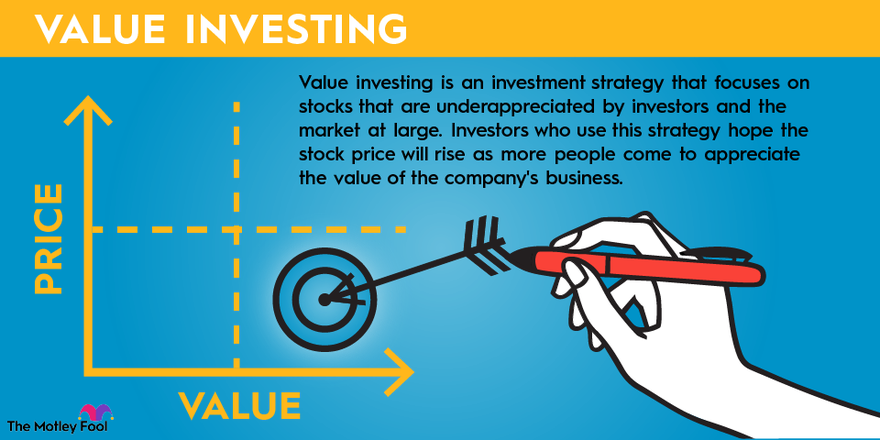Despite a bull market that began in 2023, value investors hunting for a good bargain can still find some undervalued companies on sale.
An undervalued stock is a publicly traded company that's trading for less than it should be, often for overblown short-term concerns. Typically, these companies are consistently profitable and have attractive long-term growth prospects. Share prices are also cheap compared to many of their peers and compared to the amount of future profit expected to be generated. Such stocks can be great options for patient buy-and-hold investors willing to wait for hidden bargains.

Although investors are always on the alert for a good deal, it's important to remember that some stocks are cheap for a reason. It may be that a company's growth prospects have diminished, it's losing money, or it's losing business to new competitors.
Whatever the reason, stocks like these (sometimes called value traps) are not considered undervalued even if they trade at very low prices.
Intrinsic Value
Our list of undervalued stocks in 2026
Here are five high-quality, undervalued large-cap stocks to consider, screened for profitability, and positive earnings.
| Company name | Market cap | Dividend yield | Industry |
|---|---|---|---|
| Berkshire Hathaway | $1.1 trillion | 0.00% | Diversified Financial Services |
| Berkshire Hathaway | $1.1 trillion | 0.00% | Diversified Financial Services |
| Lululemon Athletica Inc. | $24.4 billion | 0.00% | Textiles, Apparel and Luxury Goods |
| Micron Technology | $321.2 billion | 0.16% | Semiconductors and Semiconductor Equipment |
| British American Tobacco | $123.0 billion | 5.47% | Tobacco |
| Lennar | $26.2 billion | 1.95% | Household Durables |
1. Berkshire Hathaway

NYSE: BRK.B
Key Data Points
No list of value stocks would be complete without famed investor Warren Buffett's Berkshire Hathaway (BRK.A -0.08%)(BRK.B -0.21%).
Because it is a holding company, buying shares of Berkshire Hathaway gives you exposure to a private portfolio of insurance businesses (GEICO, among others), one of the largest railroads in the U.S. (BNSF Railway), an energy and utility conglomerate (including a huge renewable energy division), and various other enterprises that span industries from candy to apparel.
When it comes to public companies, Berkshire also holds significant stakes in Apple (AAPL -0.38%), Bank of America (BAC -0.52%), American Express (AXP -0.87%), Chevron (CVX +0.07%), and Coca-Cola (KO -0.23%).
2. Lululemon Athletica

NASDAQ: LULU
Key Data Points
Lululemon Athletica offers an example of a different kind of undervalued stock: a turnaround play.
Lululemon, the company that pioneered the athleisure category, has long been seen as a growth stock and carried a premium valuation. However, in 2025, the stock tumbled, losing more than 50% of its value at one point, as comparable sales growth in the core Americas segment turned negative.
The challenges got bad enough that CEO Calvin McDonald said he was stepping down, and the company would begin a search for the next CEO.
A combination of product missteps and weak consumer spending in North America has sunk the stock, but those seem to be problems the company can overcome with time. Additionally, it's delivering strong growth in China and is still opening new stores domestically and around the world, showing it has a long runway for growth.
In mid-December 2025, the stock traded at a price-to-earnings (P/E) ratio of just 16 based on its updated guidance for the year. That's almost half the price of the S&P 500 for a stock that still has a lot of long-term growth potential.
3. Micron Technology

NASDAQ: MU
Key Data Points
Micron (MU -2.32%) is a maker of memory chips and an integrated device manufacturer (IDM), meaning that it both designs and manufactures its chips.
Memory chips are notoriously cyclical as demand and prices can fluctuate wildly due to inventory gluts or changes in end-user demand. Nonetheless, Micron has historically been a winner on the stock market even as the stock has gone through multiple cycles.
These days, Micron's sales are booming thanks to AI, as the high-bandwidth memory (HBM) chips that Micron chips play a crucial role in AI servers. Its biggest customer is Nvidia (NVDA -0.46%), and analysts expect sales to jump 55% in fiscal 2026 and 17% the following year. Due to the leverage inherent in its business, profits are set to soar. Even with those expectations, the stock trades at a forward P/E ratio of just 13.4. If the company can meet or exceed those expectations, the stock looks significantly undervalued at that valuation.
4. British American Tobacco

NYSE: BTI
Key Data Points
British American Tobacco (BTI +0.12%) took a significant hit in late 2023 due to a $31.5 billion charge.
This was essentially the company writing off the value of many of its cigarette brands as worth much less than it had earlier estimated, given the industry's shift toward smokeless products.
Although the impairment affected BTI's earnings, future revenue, profit growth, and stock price, it was a non-cash-adjusting impairment.
Today, the company remains a free cash flow powerhouse, with trailing-12-month free cash flow of $9.3 billion. This robust cash flow supports a substantial dividend yield of almost 6%, with a very sustainable payout ratio of 60%.
Currently, the stock is trading at a forward P/E ratio of 12.6, which looks like a good price to pay for a strongly profitable company like British American Tobacco, even if its growth is roughly flat. Like most tobacco manufacturers, its operating margins are strong at 42%, thanks to its pricing power.
5. Lennar

NYSE: LEN
Key Data Points
Why do stocks become undervalued?
Stocks can become undervalued for a wide range of reasons.
First, the market tends to have a short-term bias. One bad earnings report can lead to a steep sell-off, which can set up an opportunity for a recovery over the longer term.
Macro conditions, like interest rates, can also lead a stock to be undervalued. These conditions are typically temporary and should change within a few years. Buying cyclical stocks during a time of macroeconomic weakness can be a winning strategy.
Stocks can also become undervalued simply because they don't fit with the market narrative. For example, artificial intelligence (AI) stocks have soared due to technological breakthroughs, but that has led investors to overlook stocks in other sectors that might not have the same growth narrative backing them up.
Finding undervalued stocks
Undervalued companies aren't necessarily the biggest ones out there. They can also be mid-cap or small-cap companies or even growth-oriented companies that trade for less than their peers.
In addition, don't just evaluate the "cheapness" of its P/E ratio or focus on its share price being low relative to its 52-week performance -- it can always go lower.
There's no universal formula for finding value stocks, but you may want to begin by checking:
- Profitability: Look at key metrics like operating margin and profit margin. Consistently high margins relative to peers indicate strong profitability.
- Return on equity (ROE): ROE measures how effectively a company uses shareholders' equity to generate profits. A higher ROE, typically above 10%, is a good sign of management efficiency and profitability.
- Return on assets (ROA): ROA indicates how efficiently a company uses its assets to generate profit. ROAs above 5% are generally considered good, but can vary by industry.
- Price-to-earnings ratio: The P/E ratio measures how much investors are paying for a company's earnings. Comparing the P/E ratio to that of the S&P 500 is one way to get a sense of the relative value of a stock. You can also compare a company's P/E ratio to its peers.
- Price-to-book ratio (P/B): A P/B ratio under 1 suggests the stock may be undervalued, but be cautious, as a very low P/B could indicate underlying problems. Compare it with the industry average for context.
- Earnings growth: Sometimes a stock is undervalued for a reason, such as poor growth prospects. Check the company's historical and projected earnings growth rates. Consistent growth is a positive indicator, while declining earnings could be a red flag.
- EV/EBITDA: This ratio compares a company's enterprise value (EV) to its earnings before interest, taxes, depreciation, and amortization (EBITDA). It provides a more comprehensive view than the P/E ratio because it factors in a company's debt. Ensure you compare the EV/EBITDA ratio to peers within the same sector to gauge relative value.
Benefits and risks of undervalued stocks
Like any other group of stocks, there are both benefits and risks to investing in undervalued stocks. Let's take a look at both sides of the coin here.
Benefits:
- Undervalued stocks are well set up to outperform the market. If the investment thesis is correct, the stock should outperform as the price moves higher to reflect the true value of the stock.
- Undervalued stocks often pay higher dividend yields since yields go up as price goes down.
- They tend to be lower-risk stocks since their price is already down.
Risks:
- The biggest risk in undervalued stocks is that you're wrong in your assessment and that the stock is a value trap.
- The stock can remain undervalued for longer than you expect.
- Market conditions change and push the stock even lower.
How to invest in undervalued stocks
- Open your brokerage app: Log in to your brokerage account where you handle your investments.
- Search for the stock: Enter the ticker or company name into the search bar to bring up the stock's trading page.
- Decide how many shares to buy: Consider your investment goals and how much of your portfolio you want to allocate to this stock.
- Select order type: Choose between a market order to buy at the current price or a limit order to specify the maximum price you're willing to pay.
- Submit your order: Confirm the details and submit your buy order.
- Review your purchase: Check your portfolio to ensure your order was filled as expected and adjust your investment strategy accordingly.
Related investing topics
Common mistakes investors make with undervalued stocks
The most common mistake investors make with undervalued stocks is mistaking a value trap for an undervalued stock. It's not always easy to differentiate between the two, but undervalued stocks tend to be temporary, while value traps are declining businesses that have low valuation ratios.
Timing is another mistake investors can make with undervalued stocks. You might identify an undervalued stock, but buy it too early, and it continues to fall before recovering. Buying stocks that are undervalued for macroeconomic reasons can present this challenge, and it's hard to know when interest rates will come down or economic growth will accelerate.
Finally, ignoring the balance sheet is another mistake to be aware of. Some stocks might look like decent businesses based on their income statements, but they could be getting crushed by debt, which explains why the stock might look undervalued, but really isn't.









